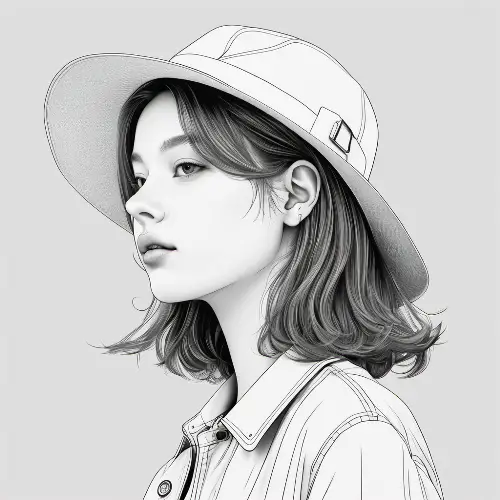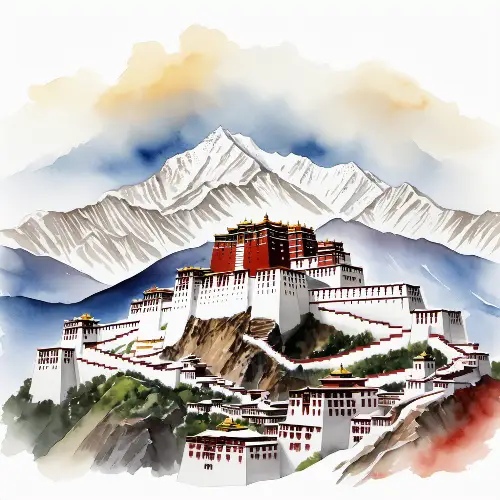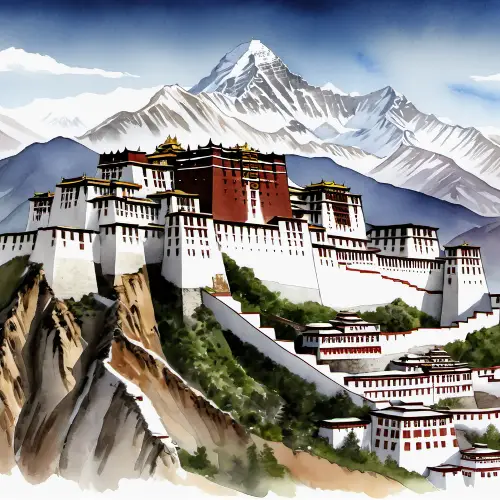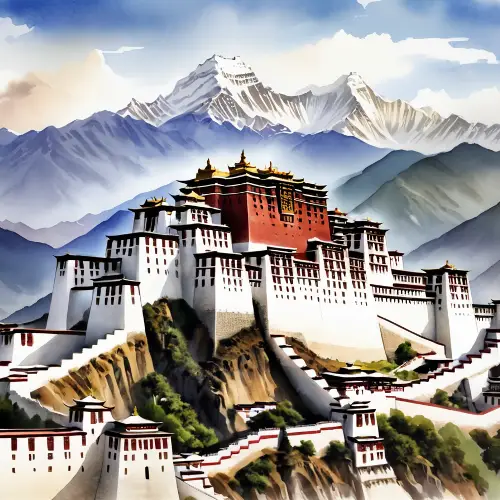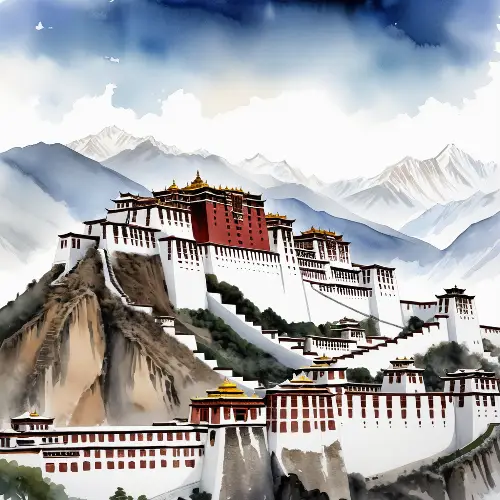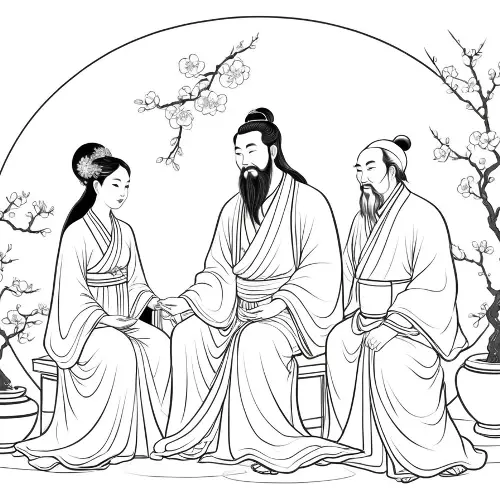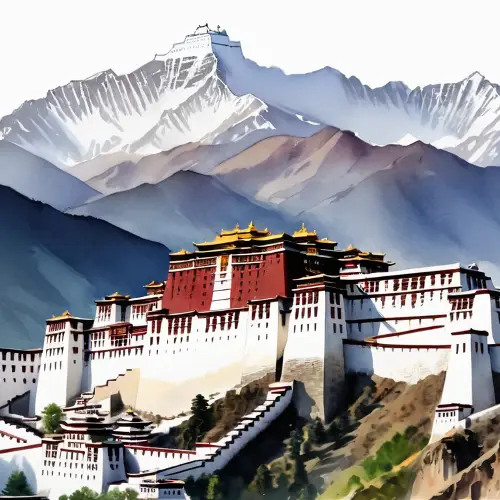Creating a black and white line art image requires a visual artist or graphic designer, as it involves translating the described scene into a 2D representation with lines and shading. However, I can provide a simplified textual representation of the scene in a style reminiscent of a black and white line art description: Title: \Vipassana Serenity\ Description: Imagine a sweeping landscape in Myanmar, where a Vipassana meditation center stands as a beacon of tranquility. The retreat is nestled amid rolling hills and framed by the graceful curves of traditional Burmese architecture. Individual meditation rooms dot the scene, each a simple, standalone structure adorned with cultural nuances. Diverse meditators engage in profound introspection within their private sanctuaries. Through open windows and doors, glimpses reveal individuals in varied postures, symbolizing the unity in their solitary pursuit of inner peace. Natural light delicately illuminates the scene, casting shadows that dance across the meditation rooms and the surrounding landscape. Symbolic elements such as lotus flowers and prayer flags add a touch of cultural richness to the image. Harmony with nature prevails, as swaying trees and the gentle ripples of a nearby pond create a serene backdrop. The time of day, whether the soft glow of dawn, the warmth of midday sunlight, or the tranquil hues of dusk, sets the mood for this visual ode to Vipassana meditation.
More Like This
Title: \Serene Solitude: Vipassana Meditation Haven in Myanmar\ Description: Capture the tranquil essence of a Vipassana meditation center nestled in the heart of Myanmar. Imagine a sprawling landscape adorned with lush greenery and traditional Burmese architecture. Your image should focus on the individuality of the meditation experience within this serene retreat. Visual Elements: Exterior Overview: Begin with an expansive view of the meditation center, showcasing the harmonious blend of nature and architecture. The main meditation hall should exude a sense of peacefulness, surrounded by well-manicured gardens and shaded walkways. Individual Meditation Rooms: Zoom in to highlight the small, standalone meditation rooms scattered throughout the grounds. Each room should reflect simplicity and tranquility, adorned with minimalistic decor. Capture the unique design of each space, perhaps featuring traditional Burmese elements. Diverse Meditators: Populate the scene with individuals engaged in Vipassana meditation. Show people of different ages, backgrounds, and walks of life, all deep in contemplation within their individual meditation rooms. Emphasize the diversity of experiences while maintaining a sense of unity in the pursuit of inner peace. Meditation Postures: Illustrate various meditation postures within the rooms, showcasing the depth of the practice. Some may be seated on cushions with crossed legs, while others may prefer kneeling or sitting on meditation benches. Highlight the serenity on their faces as they delve into their introspective journey. Natural Light and Tranquil Atmosphere: Emphasize the interplay of natural light filtering into the rooms, creating a warm and peaceful ambiance. Consider incorporating subtle details like incense, gentle breezes, or soft sounds of nature to enhance the overall atmosphere. Surrounding Landscape: Show glimpses of the lush surroundings through the windows of the meditation rooms. This should evoke a sense of being in harmony with nature, reinforcing the idea that the center provides a peaceful escape from the outside world. Ensure that the image encapsulates the essence of Vipassana meditation, emphasizing the importance of solitude and introspection within the individual meditation rooms while maintaining a harmonious connection with the broader environment. black and wite sketch
Title: \Serene Solitude: Vipassana Meditation Haven in Myanmar\ Description: Capture the tranquil essence of a Vipassana meditation center nestled in the heart of Myanmar. Imagine a sprawling landscape adorned with lush greenery and traditional Burmese architecture. Your image should focus on the individuality of the meditation experience within this serene retreat. Visual Elements: Exterior Overview: Begin with an expansive view of the meditation center, showcasing the harmonious blend of nature and architecture. The main meditation hall should exude a sense of peacefulness, surrounded by well-manicured gardens and shaded walkways. Individual Meditation Rooms: Zoom in to highlight the small, standalone meditation rooms scattered throughout the grounds. Each room should reflect simplicity and tranquility, adorned with minimalistic decor. Capture the unique design of each space, perhaps featuring traditional Burmese elements. Diverse Meditators: Populate the scene with individuals engaged in Vipassana meditation. Show people of different ages, backgrounds, and walks of life, all deep in contemplation within their individual meditation rooms. Emphasize the diversity of experiences while maintaining a sense of unity in the pursuit of inner peace. Meditation Postures: Illustrate various meditation postures within the rooms, showcasing the depth of the practice. Some may be seated on cushions with crossed legs, while others may prefer kneeling or sitting on meditation benches. Highlight the serenity on their faces as they delve into their introspective journey. Natural Light and Tranquil Atmosphere: Emphasize the interplay of natural light filtering into the rooms, creating a warm and peaceful ambiance. Consider incorporating subtle details like incense, gentle breezes, or soft sounds of nature to enhance the overall atmosphere. Surrounding Landscape: Show glimpses of the lush surroundings through the windows of the meditation rooms. This should evoke a sense of being in harmony with nature, reinforcing the idea that the center provides a peaceful escape from the outside world. Ensure that the image encapsulates the essence of Vipassana meditation, emphasizing the importance of solitude and introspection within the individual meditation rooms while maintaining a harmonious connection with the broader environment. black and wite sketch
Tea line illustration, tea leaves, black lines, sketch, white background
Tea line illustration, tea leaves, black lines, sketch, white background
Tea line illustration, tea leaves, black lines, sketch, white background
Tea line illustration, tea leaves, black lines, sketch, white background
Tea line illustration, tea leaves, black lines, sketch, white background
Tea line illustration, tea leaves, black lines, sketch, white background
Tea line illustration, tea leaves, black lines, sketch, white background
Tea line illustration, tea leaves, black lines, sketch, white background
Creating a photorealistic image that captures the essence of \"Zen\" can be a rewarding artistic endeavor. Zen, which is deeply rooted in Buddhist philosophy, emphasizes simplicity, naturalness, and a sense of tranquility. To visualize this concept, you would typically want to focus on natural elements, minimalist design, and a peaceful ambiance. Here is a step-by-step guide to help you create a photorealistic Zen-themed image: Choose Your Main Subject: Consider subjects that evoke calmness and serenity, such as a Zen garden, a simple still life with a bonsai tree, or smooth stones in sand. Select a Color Palette: Stick to muted, earthy tones like soft greens, warm browns, and grays to reinforce a natural and calming aesthetic. Plan the Composition: Aim for a balanced and harmonious composition. Use the rule of thirds to position key elements. Leave plenty of negative space to enhance the Zen concept of ma (negative space), which emphasizes the things that aren't there as much as the things that are. Set the Lighting: Soft, diffused lighting can help to create a serene mood. Consider the time of day that best reflects the peace of Zen, like early morning or dusk. Incorporate Texture: Detailing with texture such as raked sand patterns or the bark of a bonsai tree will add to the realism. Add Simplistic Elements: Elements like a single leaf or pebble can symbolize the Zen principle of kanso (simplicity). Focus on Detail and Realism: Pay attention to small details like shadows, reflections, and textures to enhance the photorealistic quality. Post-Processing: Use photo editing software to fine-tune colors, contrast, and saturation, and to ensure a natural look is maintained. Review and Reflect: Look at the image as a whole and consider if it truly conveys a sense of Zen. It should inspire a viewer to feel more mindful, present, and at peace.
Creating a photorealistic image that captures the essence of \"Zen\" can be a rewarding artistic endeavor. Zen, which is deeply rooted in Buddhist philosophy, emphasizes simplicity, naturalness, and a sense of tranquility. To visualize this concept, you would typically want to focus on natural elements, minimalist design, and a peaceful ambiance. Here is a step-by-step guide to help you create a photorealistic Zen-themed image: Choose Your Main Subject: Consider subjects that evoke calmness and serenity, such as a Zen garden, a simple still life with a bonsai tree, or smooth stones in sand. Select a Color Palette: Stick to muted, earthy tones like soft greens, warm browns, and grays to reinforce a natural and calming aesthetic. Plan the Composition: Aim for a balanced and harmonious composition. Use the rule of thirds to position key elements. Leave plenty of negative space to enhance the Zen concept of ma (negative space), which emphasizes the things that aren't there as much as the things that are. Set the Lighting: Soft, diffused lighting can help to create a serene mood. Consider the time of day that best reflects the peace of Zen, like early morning or dusk. Incorporate Texture: Detailing with texture such as raked sand patterns or the bark of a bonsai tree will add to the realism. Add Simplistic Elements: Elements like a single leaf or pebble can symbolize the Zen principle of kanso (simplicity). Focus on Detail and Realism: Pay attention to small details like shadows, reflections, and textures to enhance the photorealistic quality. Post-Processing: Use photo editing software to fine-tune colors, contrast, and saturation, and to ensure a natural look is maintained. Review and Reflect: Look at the image as a whole and consider if it truly conveys a sense of Zen. It should inspire a viewer to feel more mindful, present, and at peace.
Creating a photorealistic image that captures the essence of \"Zen\" can be a rewarding artistic endeavor. Zen, which is deeply rooted in Buddhist philosophy, emphasizes simplicity, naturalness, and a sense of tranquility. To visualize this concept, you would typically want to focus on natural elements, minimalist design, and a peaceful ambiance. Here is a step-by-step guide to help you create a photorealistic Zen-themed image: Choose Your Main Subject: Consider subjects that evoke calmness and serenity, such as a Zen garden, a simple still life with a bonsai tree, or smooth stones in sand. Select a Color Palette: Stick to muted, earthy tones like soft greens, warm browns, and grays to reinforce a natural and calming aesthetic. Plan the Composition: Aim for a balanced and harmonious composition. Use the rule of thirds to position key elements. Leave plenty of negative space to enhance the Zen concept of ma (negative space), which emphasizes the things that aren't there as much as the things that are. Set the Lighting: Soft, diffused lighting can help to create a serene mood. Consider the time of day that best reflects the peace of Zen, like early morning or dusk. Incorporate Texture: Detailing with texture such as raked sand patterns or the bark of a bonsai tree will add to the realism. Add Simplistic Elements: Elements like a single leaf or pebble can symbolize the Zen principle of kanso (simplicity). Focus on Detail and Realism: Pay attention to small details like shadows, reflections, and textures to enhance the photorealistic quality. Post-Processing: Use photo editing software to fine-tune colors, contrast, and saturation, and to ensure a natural look is maintained. Review and Reflect: Look at the image as a whole and consider if it truly conveys a sense of Zen. It should inspire a viewer to feel more mindful, present, and at peace.
**Text-to-Image Prompt: \"Ephemeral Serenity\"**Create a captivating painting that captures the essence of fleeting tranquility. Imagine a serene landscape where soft hues blend seamlessly, evoking a sense of calmness and peace. Incorporate subtle details that invite viewers to lose themselves in the ethereal beauty of the scene. This painting should radiate a timeless charm, making it a cherished piece for those seeking solace in the delicate balance between simplicity and sophistication. The final artwork should convey a profound emotional connection, offering potential buyers a visual escape worth investing in, priced at $1000.
**Text-to-Image Prompt: \"Ephemeral Serenity\"**Create a captivating painting that captures the essence of fleeting tranquility. Imagine a serene landscape where soft hues blend seamlessly, evoking a sense of calmness and peace. Incorporate subtle details that invite viewers to lose themselves in the ethereal beauty of the scene. This painting should radiate a timeless charm, making it a cherished piece for those seeking solace in the delicate balance between simplicity and sophistication. The final artwork should convey a profound emotional connection, offering potential buyers a visual escape worth investing in, priced at $1000.
Create a simple black and white line art icon depicting a sparkling, effervescent effect
Create a simple black and white line art icon depicting a sparkling, effervescent effect
A black background with the outline, in white, of a roberval balance, a balance, magical, mystical linear art, line art, linear, for logo
Create a visual masterpiece that encapsulates the profound tranquility of Vipassana meditation within the confines of a traditional pagoda. Picture a serene landscape where a majestic pagoda, adorned with intricate details, stands as a haven for introspection. Pagoda Overview: Begin with an exterior view of the pagoda, showcasing its grandeur against the backdrop of a calm natural setting. Emphasize traditional architectural details, such as tiered roofs and ornate spires, to evoke a sense of sacredness. Individual Meditation Cells: Zoom in to depict the interior of the pagoda, revealing individual meditation cells. Each cell should exude simplicity and spiritual ambiance, with minimalistic furnishings, soft lighting, and a serene atmosphere conducive to meditation. Meditators in Silence: Populate the cells with Vipassana meditators engaged in silent contemplation. Illustrate various meditation postures, such as seated on cushions or meditation benches, with their eyes closed and a focused yet serene expression. Highlight the diversity of practitioners. Play of Light: Use the play of natural light within the pagoda to create a peaceful and meditative ambiance. Show how light filters through intricately designed windows, casting gentle rays on the meditators and the surroundings. Symbolic Elements: Integrate symbolic elements like lotus flowers, traditional meditation tools, or subtle patterns on the pagoda walls, adding depth and cultural significance to the scene. Harmony with Nature: Surround the pagoda with elements of nature – perhaps glimpses of a tranquil garden, swaying trees, or a reflective pond. Reinforce the idea that the pagoda is in harmony with its natural surroundings. Time of Day: Consider the time of day to set the mood – whether its the soft hues of dawn, the warmth of midday sunlight, or the serene tones of dusk. Align the chosen time with the meditative atmosphere you wish to convey.
A clean background ,The Potala Palace is surrounded by snow-capped mountains, There is a white tower at the bottom of the mountain, Buddhism, Zen, watercolor style, Stroke, blank-leaving, red and Off-yellow, panoramic view, white background ,Clean and neat composition --ar 4:3
The visual representation embodies the essence of Eastern artistic principles, portraying a misty mountain landscape with a solitary pagoda nestled amidst lush green hills, symbolizing solitude and spiritual enlightenment, Illustration, employing digital art techniques to render intricate details and capturing the ethereal quality of the mist, --ar 16:9 --v 5
A clean background:1, The Potala Palace is surrounded by ::2 snow-capped mountains, There is a white tower at the bottom of the mountain, Buddhism, Zen, watercolor style, Stroke, blank-leaving, panoramic view, white background,Ultra HD, ultra detail, master works,
Create a serene image representing mindfulness, such as a person meditating, practicing yoga, or engaging in a peaceful activity. Use calming colors and a tranquil background. Indian Female
Create a serene image representing mindfulness, such as a person meditating, practicing yoga, or engaging in a peaceful activity. Use calming colors and a tranquil background. Indian Female
Create a serene image representing mindfulness, such as a person meditating, practicing yoga, or engaging in a peaceful activity. Use calming colors and a tranquil background. Indian Female
A clean background, The Potala Palace is surrounded by snow-capped mountains, There is a white tower at the bottom of the mountain, Buddhism, Zen, watercolor style, Stroke, blank-leaving, panoramic view, white background --ar 4:3
Create a serene image representing mindfulness, such as a person meditating, practicing yoga, or engaging in a peaceful activity. Use calming colors and a tranquil background.
Create a serene image representing mindfulness, such as a person meditating, practicing yoga, or engaging in a peaceful activity. Use calming colors and a tranquil background.
Thats all, you cant stay there for a long time. Because I definitely miss Quail Street all the time. I miss Uncle Ermian Gua, Chen San, Lao Jiang and his cross-eyed grandson. I will never believe in Jesus who hung on the cross just because I immigrated overseas. I must always miss the God of Wealth, Guanyin Bodhisattva, Peach Blossom Fairy and Emperor Zhenwu at home. Black and white ink painting style
Chinese element, pattern, wallpaper, format: image, black and white, 2d illustration
A clean background, The Potala Palace is surrounded by snow-capped mountains, There is a white tower at the bottom of the mountain, Buddhism, Zen, watercolor style, Stroke, blank-leaving, panoramic view, white background













